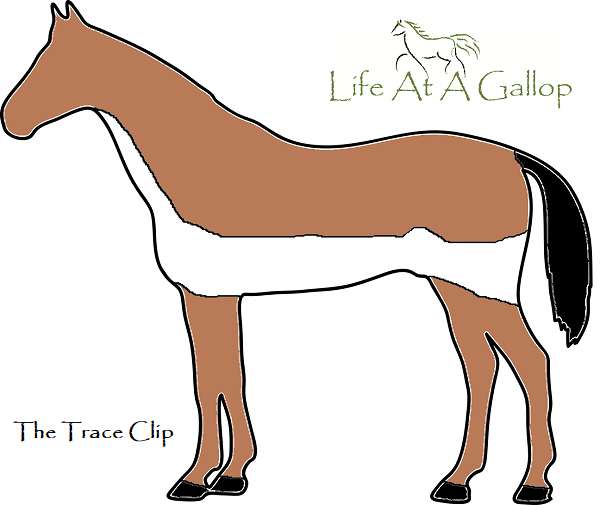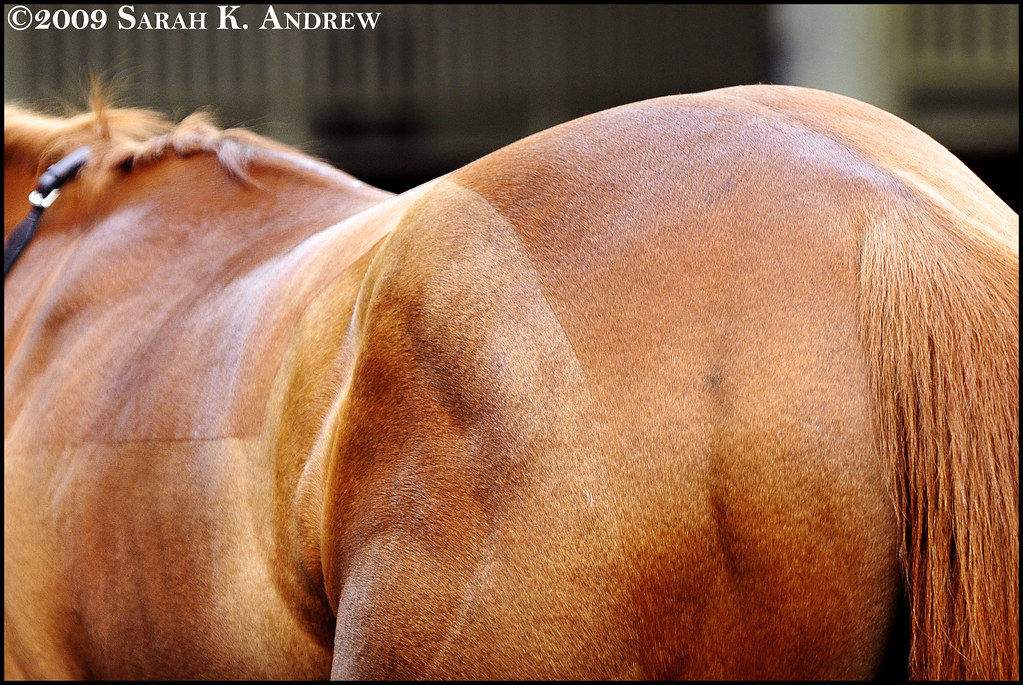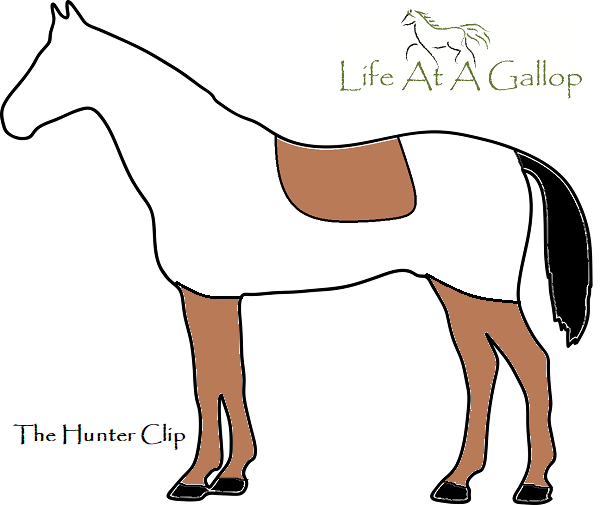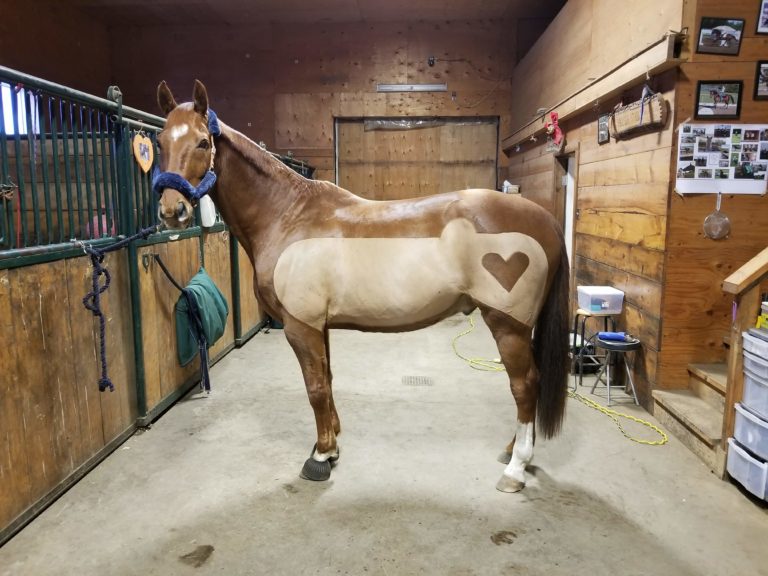
How To Clip A Horse Clipping for the first time, Bib, Chaser and Trace Clip YouTube
Watch professional horse groom and body clipping business owner Shannon O'Hatnick explain when and why you might need to give your horse a trace clip or full body clip, what equipment you need, and handy tips and tricks to give your horse that sleek, professional look. This video is brought to you by SmartPak. About This Video

Horse Clipping Styles Life At A Gallop Equestrian Blog Cheshire
Trace Clip A trace clip may be extended to include part or all of the head and neck, or along the lower edge of the hindquarters. This clip is useful for horses in moderate work that sweat at the bottom of their neck and flanks. There are a few ways to do trace clips, a high trace clip includes at least part of the neck and shoulder, and brings the line off the clip higher up on the belly.

Clipping The Different Types of Clip Everything Horse
Silver Lake Park. Photos (2) Directions. Print/PDF map. More. Length 1.0 miElevation gain 13 ftRoute type Loop. Discover this 1.0-mile loop trail near Middletown, Delaware. Generally considered an easy route, it takes an average of 18 min to complete. This trail is great for road biking, running, and walking, and it's unlikely you'll encounter.

Trace clip for showing? The Horse Forum
Trace. A trace clip is similar to a blanket clip, but less of the neck is clipped. You can modify the cut as needed depending on how much your horse works—the harder he works, the more of the neck you'll clip, says Daddario. Starting with a trace clip is a low-stress way of introducing your horse to the horse clipping process, says Morgan.

5 Different Types Of Horse Clips COWGIRL Magazine
The higher a blades number, the more hair it removes. In the horse world, you usually find blades between #8.5 and #40. The #8.5 or #10 is typical for body clipping. You would use a #30 or #40 to remove as much hair as possible for cleaning wounds. Each number correlates to the length of hair that remains.

Trace Clip From Flickr
Trace Clip. The trace clip is a very popular clipping style. With this type of clip, the horse's neck, chest, and belly are clipped, and most of the sides and back are left unclipped.. When clipping a horse's face, be sure to go slowly and be careful not to clip too close to the horse's eyes or mouth. Here's a quick guide to horse face clipping:
Clipping 101 Horse Journals
Horse clipping is the process of shaving off the top layers of a horse's coat so that it is shorter than it would be naturally. There are many levels of clipping, from quickly trimming overgrown parts that cause annoyance to removing large sections of the coat for competition purposes.

What You Need To Know About Body Clipping Your Horse. Farm House Tack
Horses who have metabolic or endocrine challenges - such as Equine Metabolic Syndrome (EMS) or Cushing's Disease may require body or trace clipping. This is to help them be comfortable, with or without exercise, year-round.

A guide to trace clips EQUINE Ink
If your horse is suffering from conditions such as Cushing's or Equine Metabolic Syndrome (known as EMS) then clipping him all year round will help him to maintain a normal body temperature. You don't need to give your horse a full clip, even a chaser or trace clip will allow him to cool enough. Other reasons for clipping

Horse Clipping Styles Life At A Gallop Equestrian Blog Cheshire
Determining Whether to Body Clip Workload: The horse's workload over the winter can greatly determine if you clip and what type of clip you do. Horses in heavy work that live in moderate temperatures may need a full-body clip to be comfortable, while horses that live in cold climates doing the same amount of work may need a more modified clip.

Trace Clip Horses, Horse clipping, Horse pictures
Hazel of Billow Farm demonstrates how to clip your horse with a Trace Clip.Video produced by Chris Atkin ( http://horse-clips.co.uk/videos )Also available:Hu.

Horse Clipping Q&A Andi's Clipping The Yeg Equestrian
A trace clip can be high or low - the difference being how far up the horse's flank that the hair is clipped. The hair is left on the head, the topside of the neck and body and also on the legs for warmth and protection. The Blanket ClipIn the Blanket Clip is more radical than the trace clip. The hair on the neck and flanks is removed.
.jpg)
Clipping 101 Horse Journals
Trace clipping is the perfect way to get the best of both worlds - your horse won't sweat through his winter coat, and all of his other parts are still fuzzy and protected. But trace clipping your horse is often more complicated than a body clip - you must contend with borders. Jump to videos and shopping Which trace clip is best for your horse?

A guide to trace clips EQUINE Ink
This clip is designed for horses that maintain a regular work load in the winter. The advantage to this clip over a full-body clip is that hair is left along the horse's back and upper neck for protection during cold-weather rides, so you shouldn't need a quarter sheet for riding.

Great example of a low trace clip Trace clip, Horse clipping, Horse grooming
A guide to trace clips Liz Goldsmith Commentary, grooming, Horse care horse grooming, horses, trace clipping, trace clips 5 Comments The Peasride Clipper Advice site provides handy diagrams of different ways to clip. I rarely do a full clip on my horses since they've always spent lots of time outside.

trace clips Google Search Horse care, Horses, Horse body clipping
2335 Partial Clips: The Low Trace Clip You plan to ride all winter but you don't have an indoor ring. Your horse's work load will depend on the weather—walking in bad footing, regular work when your outdoor ring thaws. This clip will allow your horse ventilation in active training, while giving him protection during those long cold walks.